Sith was the native language of the people of Ziost and Korriban. It was adopted as the mystical language of the Sith Order after the Dark Jedi Exiles enslaved the Sith species. Sith was an agglutinative language, in which words or even phrases were made up of linears sequences of distinct meaningful units. Despite the preeminence of the Galactic Basic Standard, the Sith language remained in use up until the post-Imperial era. To the Lost Tribe of Sith, an order founded on the remote planet Kesh, the Sith language was known as the Old Tongue.
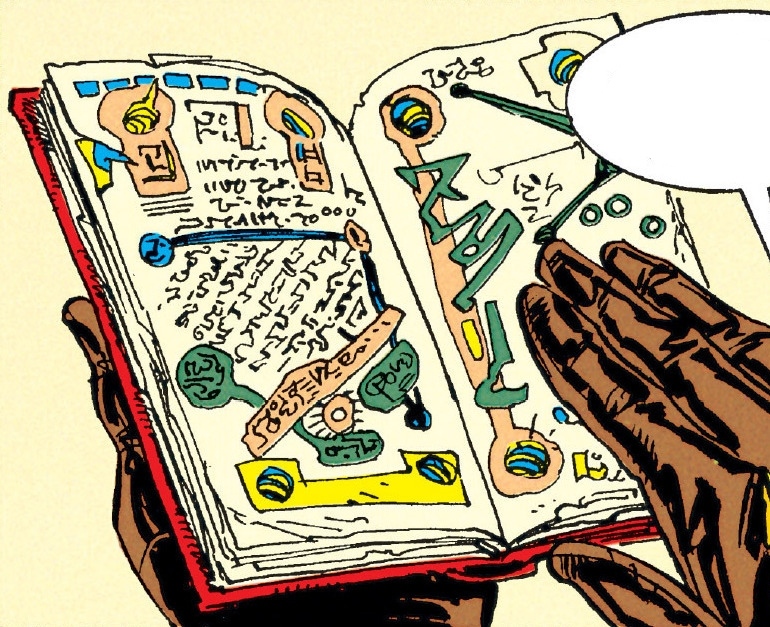
The spellbook of Freedon Nadd was written in Sith
Originally, this language was only spoken by the Sith, a species of red–skinned Humanoids from the Stygian Caldera. It was later expanded upon and evolved when the second generation of Dark Jedi split from the Jedi Order in 7000 BBY, just after the Battle of Corbos, and enslaved the natives of Korriban. The Sith language became a symbol of the newly created Sith Order, a powerful sect of dark side adepts. This was made easier through the creation of devices known as translation talismans. Such artifacts, initially designed and created by the Jedi Exiles who sought to learn of the Sith's secrets, allowed their wearer to read the Sith language as if it were their own mother tongue. The Code of the Sith, originally penned in Basic by the Exile Sorzus Syn and inspired by the lifestyle of the Sith Purebloods, was also translated in Sith language as Qotsisajak.
Around 5000 BBY, the Sith dreadnaught Omen was forced to crash land on the remote planet Kesh. The marrooned Sith were never able to to return to space, so they settled amongst the native Keshiri and founded the Lost Tribe of Sith. This allowed the Sith language to expand far from its cradle. In this marginal Sith colony, the language became known as "the Old Tongue".
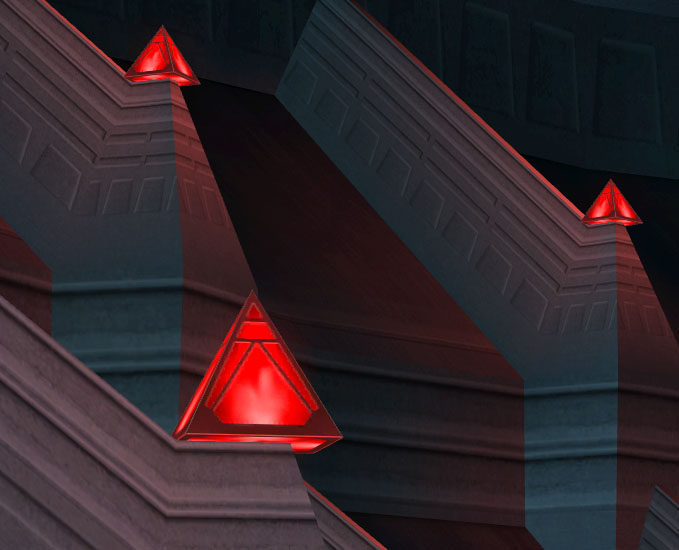
Three of Master Atris's Sith holocrons
Even after the majority of Sith were of other species than the Sith Pureblood, the language was preserved in holocrons, temples, and tomes. However, outside of the dark side circles, very few scholars knew how to decipher this language, and even fewer could pronounce its complex word structures. Much later, in the eleventh century before the Battle of Yavin, the Human Darth Bane became familiar with the tongue of the ancient Sith during his studies at the Academy of Korriban, unlike most of his fellow students. Bane would seek the wisdom of Masters long dead in leather-bound volumes covered with blood-red ink.
Millennia after the founding of the Sith Order, individuals as modern as the fallen Jedi Vergere and Jerec or the Sullustan Dr'uun Unnh, spoke it. The members of the Lost Tribe of Sith also managed to preserve the knowledge of the Old Tongue, and all members from apprentices and higher knew it. For example, Vestara Khai was able to use it to communicate with a pack of Tuk'ata on Korriban. The last members of the Order of the Sith Lords founded by Bane, Darth Sidious and his successive apprentices Darth Maul, Darth Tyranus and Darth Vader, were all capable of speaking Sith fluently.
The phonetic palette of the Sith language consisted of 23 phonemes or speech sounds. There were approximately 11 obstruents and 6 or 7 sonorants: /t/, /d/, /k/, /q/, /m/, /n/, /ts/, /dz/, /s/, /z/, /h/, /t͡ʃ/,/j/ /ʃ/, [ɹ/l], /w/, /ʎ/ . Accordingly, the graphemic system to represent these was t, d, k, q, m, n, ts, dz, s, z, h, ch, j, sh, r/l, w, y.
There were also 6 distinct vowels: /i/ or i (as in "heat"), /æ/ or â (as in "bash"), /u/ or u (as in "suit"), /ʌ/ or û (as in "club"), /oʊ/ or o (as in "toad"), /ɑ/ or a (as in "ah"). In addition, a and o would combine with i to make diphthongs: oi (as in "toy") and ai (as in "buy"). The epenthetic vowel was /u/.
Because of this limited segment inventory, Sith scribes faced difficulties when trying to translate non-Sith names. For example, the name of Palpatine would have to be transcribed as Marmûtin, as the Sith language did not have a "p" sound or an "l" between two consonants. To overcome such difficulties, creative scribes would actually translate the name into their language based on its etymology. Assimilation from borrowed lexical items is preferred by place of articulation: in Palpatine, /p/ > /m/
Sith morphemes—the smallest meaningful units in the grammar of a language—were often made of closed syllables (syllables ending with consonants), which made them sound brisk and choppy. The language was regularly stressed, with every word accented on the first syllable.
The Sith language discouraged vowels in hiatus, and glides /j/ or /ʎ/ were inserted when two vowels appeared next to each other. The phrase siqsayanjat ("about a demon") was in fact composed of siqsa ("demon") and anjat (ablative noun marker), with the addition of the glide y to eliminate the hiatus.
The language of the Sith extensively employed regular agglutination and used derivative suffixes to a greater extent than Galactic Basic Standard. Many different markers could be added to a root until very long words were formed—and a single word could constitute an entire sentence. For example, the phrase "because of dreaming about a demon" translated in Sith as a single word kûskutsiqsayanjat. This word was made of four distinct morphemes: kûsk + ut + siqsa + (y)anjat = "to dream" + (nominal verb marker) + "demon" + (ablative noun marker). Some markers could be added only to nouns, and others only to verbs.
The typical declarative word order of Sith was verb / subject / object — for example, "Wonoksh Qyâsik nun" was literally "Shall free / the Force / me". However, there also existed prepositional phrases, and subjects or objects could sometimes be put at the front of the sentence for emphasis.
Verb roots were typically one syllable and ended with a consonant. Moods, tenses, and other subtleties were indicated by suffixation verb markers. For example, the addition of -atul expressed the alethic mood, the speaker's belief that an action was logically necessary or obviously true. (The phrase Châts nu midwan would be "I gain power", while its alethic form Châtsatul nu midwan could be translated as "I necessarily gain power.") Also, the addition of -oksh expressed future tense. (For instance, Won Qyâsik nun meant "The Force frees me," while Wonoksh Qyâsik nun meant "The Force shall free me.") The suffix -win was sometimes added to a transitive verb to indicate ergativity, meaning that the grammatical subject of that verb was in fact its semantic object, while the true semantic agent remained unexpressed. (In the phrase kotswinot itsu or "my chains break," the action described is in fact being done to the subject itsu by an undetermined agent.) Thanks to the suffix -ut, verbs could also be nominalized. (For example, kûsk was "to dream" while kûskut was "the act of dreaming.")
Sith nouns had cases, inflectional forms indicating their grammatical relation to other words in the sentence. Those cases were expressed by the addition of a noun marker. Known cases were the instrumental case (-jontû), the ablative case (-anjat), the dative case (-ottoi). Instrumental case indicated that the noun it marked was the means of the accomplishment of the action expressed by the clause; for instance, ashajontû meant "through victory." As regards the ablative case, it could be best translated in Basic using the preposition "about." The word siqsayanjat meant "about/concerning a demon." A noun was in the dative case when it was used as an indirect object: midwan was "power" while midwanottoi meant "for/to the power."
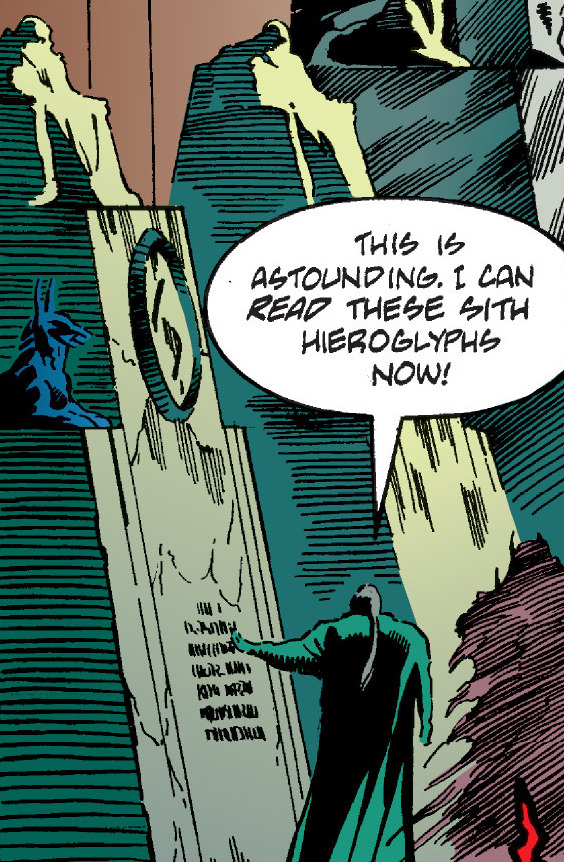
Exar Kun reading Sith hieroglyphs
The Sith language was originally written in complex hieroglyphics. Over the centuries, Sith scribes wished to develop less complicated scripts. This resulted in the creation of two different scripts. The first one, known as "Common Sith" was used for mundane, everyday use, while the other, "High Sith" was for ecclesiastical use. A third writing system known as the Kittât was also used for incantation scrolls. The latter consisted of thirty-seven runes, and was suitable for both calligraphy and epigraphy.
The Massassi warriors who followed the Sith Lord Naga Sadow in exile on the fourth moon of Yavin Prime also developed their own hieroglyphic system, a simplified version of High Sith. They carved many inscriptions using this new writing system on temple walls and obelisks scattered across the jungle of Yavin 4, notably in the Temple of the Blueleaf Cluster or at the monumental rear entrance of the Great Temple. When the Sullustan naturalist Dr'uun Unnh explored Yavin 4 on behalf of the Alliance to Restore the Republic, he successfully translated some of the Massassi texts contained in the Temple of Exar Kun. When the New Jedi Order of Luke Skywalker established its academy on Yavin 4, Skywalker and some of his students learnt to decipher that script, which allowed them to read the Books of Massassi.
- Dzworokka yun; nyâshqûwai, nwiqûwai. Wotok tsawakmidwanottoi, yuntok hyarutmidwanottoi.—"Two there should be; no more, no less. One to embody power, the other to crave it."
- Eyah seh maat, shu kor huaan.—Unknown. Something soothing.
- Haa, neyo la yud masur kee, tah uhnah kahru lur shu.—Unknown. Something menacing and challenging.
- Ja'ak.—"I am free."
- Na-hah ur su ka-haat. Su ka haru aat.—Unknown. Most likely something as: "Lead the Sith to us if there are any here."
- Taka zeech ma toka duuwaj.—Unknown. An incantation to gain access to a Sith obelisk.
- Ur-kaa!—Unknown. Probably something such as "Halt!" or "Freeze!"
- Vexok savaka.—"Wake up, there is work to do."
- Zhol kash dinora.—"It is done."
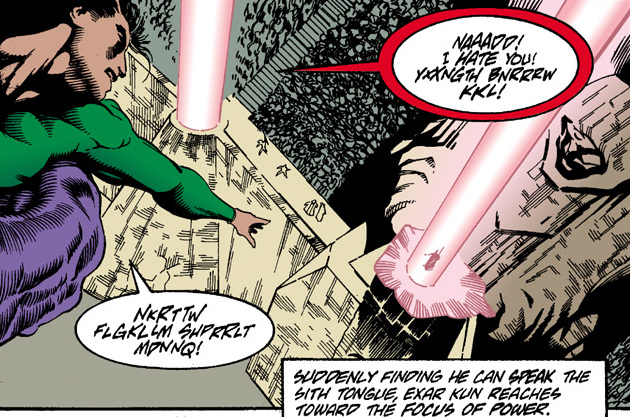
Early incarnation of the Sith language
The Sith language first appeared in the 1990s comic book series Star Wars: Tales of the Jedi. At the time, occurrences of that language consisted of nonsensical words, composed only of unpronounceable series of consonants—such as Nkrttw flgkllm shprrlt mdnnq. This version of Sith does not blend well with ulterior appearances in canon, and should probably be considered an artistic license. In Speak Like a Sith, Ben Grossblatt noted that no one would even try to speak a language if it consisted of unpronounceable words like r'rhhoqtk. However, in the audio drama adaptation of Tales of the Jedi, the instances were Exar Kun speaks Sith sounded very different from their comic book counterpart, featuring a variety of vocalic sounds.
In the 2004 video game Star Wars: Knights of the Old Republic II: The Sith Lords, Darth Nihilus was heard communicating in the same fashion as the Sith holocrons kept by Atris, leading some fans to believe that the Dark Lord spoke Sith. However, when working on the Knights of the Old Republic Campaign Guide, Star Wars author Abel G. Peña wrote a whole passage devoted to Nihilus' mask that was ultimately cut. It would have notably provided two scholarly explanations of Nihilus' speech. According to that cut passage, the Dark Lord's hissings may have either been the last language ever spoken in the galaxy, billions of years into the future, at the end of time, or the raw dialect of the Force itself, untranslated by midi-chlorians.
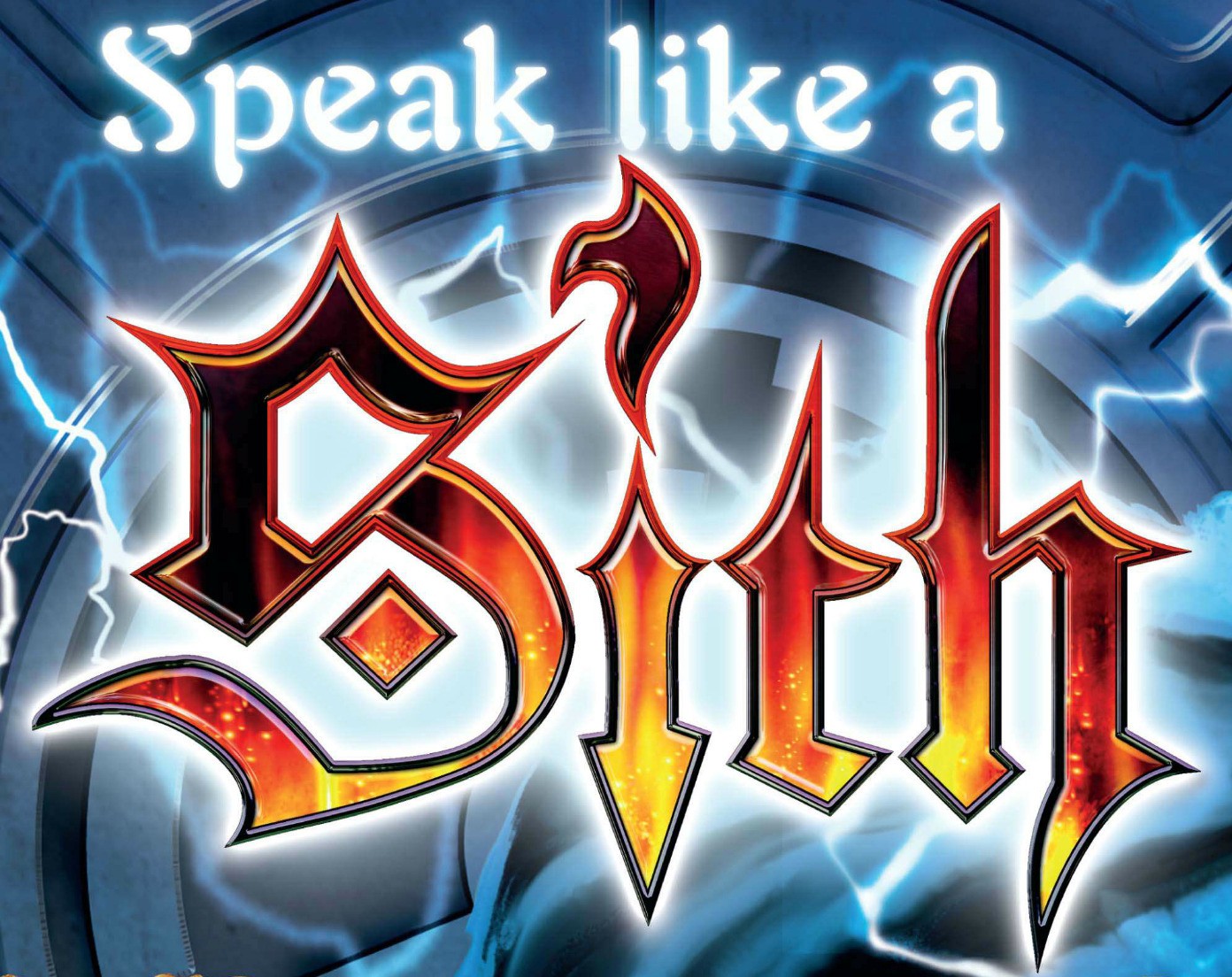
Speak Like a Sith
In November 2010, senior editor Ben Grossblatt, who has degrees in linguistics, created a functional Sith language for the Book of Sith: Secrets from the Dark Side. His work included Sith rules of grammar and sentence construction and a Sith runic script. More information about the creation of this language was revealed in Speak Like a Sith, an article featured in the Star Wars Insider 134. Sith is the second working conlang ever developed for the Star Wars universe, the first being Karen Traviss' Mando'a.
While Grossblatt's system is realistic and functional, there are conflicts between his version of the Sith phonology and Sith vocabulary established in previous works. While the Star Wars Insider article states that the Sith has no 'e' 'p' or 'f' sounds, words or names such as "derriphan" "Ffon," "aleph", Jen'ari, Jen'jidai, Jensaarai or "Kressh" have appeared in older canon sources. Not even "Korriban", the name of the Sith species' homeworld, can be written using this system, due to the lack of 'b'. In fact, even some of the new words that were invented for Book of Sith—including "Grotthu" and "Zuguruk"—cannot be properly transcribed. Although Grossblatt did create "new" Sith words consistent with his conlang for the caste names, they did not make it into the final version of the book.